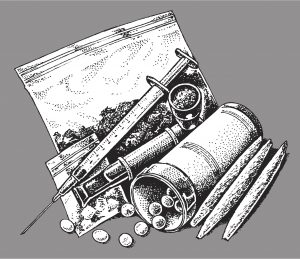by Sher Delva | Jul 5, 2017 | Addiction

Benzos are so overused that they top all prescriptions in psychiatric medicine and are among the most prescribed medication of any type in the United States. Nearly 50 million benzos prescriptions are written every year.
Prescriptions for benzos have skyrocketed over the past two decades. Between 1996 and 2013, the number of prescriptions for benzodiazepines more than tripled and fatal overdoses more than quadrupled.
What’s the Big Deal?
Benzos are known for helping with anxiety disorders and insomnia, so what’s the big deal if they are heavily prescribed?
Well, there are a couple of reasons why this is a major problem.
First, there is evidence indicating these drugs do not work well over the long-term. Studies reveal that long-term use of benzos can increase anxiety symptoms. Furthermore, it is possible to treat anxiety and sleep disorders without medication, or at least with other medications besides benzos.
The second problem is the addiction and dependence risk. People who receive high doses of benzos can become physically dependent fairly quickly. Without medical supervision, the withdrawals from benzos are severe, ranging from intensified anxiety to high blood pressure, seizures, and convulsions.
The longer someone uses benzos, the greater the likelihood of addiction. People who misuse benzos tend to take higher-than-prescribed doses or mix the pills with alcohol or other drugs. Benzos are often chewed or crushed which interferes with the timed-release formula and speeds up the effects. This way of using benzos is extremely dangerous.
A Deadly Combination?
The true dangers of benzos really amplify when they are taken with other substances like opioids and alcohol. The risk of combining benzos and opioids is well-known, yet many doctors prescribe benzos and opioids together to patients.
From 2001 to 2013, benzos and opioid prescriptions increased by 80%, according to an analysis by researchers at the Stanford University School of Medicine. It is not considered safe to use both together yet this is fairly standard practice.
Opioids vs. Benzos?
Highlighting the dangers of benzos is not intended to diminish the significant dangers of prescription painkillers. Make no mistake, we are in the midst of an opioid epidemic, and opioid addiction has become a national crisis. However, in 30 percent of opioid-related deaths, a combination of benzos and opioids caused the overdose. That’s why it is so important to talk about benzos when we are discussing the opioid epidemic.
Why is this combination so deadly?
Opioids and benzos both slow down the body systems, particularly the respiratory and cardiovascular systems. Therefore, it is not difficult to understand why this combination is so risky. You are essentially combining two substances that slow down the functioning of your body. If you add a cocktail on top of that, it only compounds the problem. In worse case scenarios, this combination of substances causes breathing to stop.
In addition, alcoholics regularly abuse the benzo alprazolam, known by its brand name Xanax. Alcohol is a depressant so combining alcohol with the sedative effects of benzos increases the likelihood of overdose and respiratory failure.
Should Doctors Take the Blame?
The use of benzos often begins in the form of a prescription. Dual prescriptions of benzos and opioids are far from uncommon. Doctors are more likely to prescribe to patients who complain of pain, anxiety, and insomnia during a limited 15-minute consultation time.
In this rushed state, a physician may desire to help a patient but not have the time to explore the underlying causes. Therefore, medication becomes the easiest treatment. It unclear whether doctors are adequately warning their patients of the potential dangers of combining these drugs to help prevent addiction. As for now, it is difficult to place the blame on one person or thing, but one thing is for certain: people need to know the risks.
—
Overall, more and more people are struggling with addiction, and overdose death numbers have reached epidemic levels. If you are currently struggling with addiction, please do not wait. Recovery is possible. Call toll-free today.
CALL NOW 1-888-922-5398
by Sher Delva | Jun 28, 2017 | Addiction, Addiction Stigma, Addiction Treatment, Drug Abuse, Mental Health, Prescription Drugs, Stigma, Therapy, Uncategorized

One Ohio City is fed up with dealing with drug addicts who overdose over and over again.
Their solution? Simple: Three strikes and you’re out.
But is this really the right way to go about this?
Recently, Dan Picard, a councilman from Middletown, Ohio proposed a new strategy to handle the influx of overdose calls in his city. He claims the city had spent $100,000 on the lifesaving drug. His solution is to limit the number of times an addict can be revived with Narcan.
“It’s not a proposal to solve the drug problem,” Picard said this week. “My proposal is in regard to the financial survivability of our city. If we’re spending $2 million this year and $4 million next year and $6 million after that, we’re in trouble. We’re going to have to start laying off. We’re going to have to raise taxes.”
While it may seem extreme, Picard believes something must be done to reduce the hundreds of thousands of dollars spent administering the overdose antidote Naloxone.
According to the National Institute of Health, Naloxone, also known by the brand name Narcan, is a “medication designed to rapidly reverse opioid overdose.”
How the Proposed Plan Works
The plan proposed states that anyone who overdoses twice must complete community service equivalent to the cost of administering the Narcan. If the person has been provided Narcan two overdoses before and has not completed the required community service requirement, dispatchers will not send help their way.
“If the dispatcher determines that the person whose overdosed is somebody’s that’s been part of this program for two previous overdoses and has not completed community service and has not cooperated in the program, then we wouldn’t dispatch,” Picard explains.
Middletown has seen a significant spike in overdoses. Just last year alone, there were 532 overdoses reported. It may sound extreme, but Picard insists the city cannot afford to continue responding to overdoses at the same rate.
“We’ve got to do what we’ve got to do to maintain our financial security, and this is just costing us too much money,” he told NBC affiliate WLWT.
This city of Middletown, Ohio spent three times as much on Narcan this year as they did all of 2016. The numbers in 2017 already surpass that of the previous year at 577 overdoses so far.
Numbers Soar Throughout Ohio
All across Ohio, communities like Cleveland, Elyria, Parma, Chardon, and others have seen people need Narcan again and again after overdosing on opioids.
As of right now, the fire department is required by law to provide Narcan in response to an overdose. The legal department is reviewing this plan proposed by Picard. In the meantime, the fire department is applying for grants and donation to increase funds for Narcan.
Sal Valdez, the Clinical Coordinator for American Medical Response in Rochester, stated to a local news station, that he responds to at least four drug overdoses every day and about 80 every month. Each time, paramedics administer Narcan, they could need multiple doses. He also notices overdoses occurring in similar areas to repeat offenders.
“Sometimes we do know these patients by name,” Valdez said. “In my experience, we do see the same patients over and over again, and we respond to the same locations.”
Way Too Extreme?
One study estimates the cost of the prescription drug opioid epidemic costs American society $78.5 billion. Regardless, many find this proposed strategy way too extreme. This could mean the difference between life and death for some, preventing them the opportunity to recover.
Daniel Raymond, the deputy director of the Harm Reduction Coalition, told the Washington Post, that he’s “disappointed” by Picard’s plan of action. He noted that the proposal was an insult to families of loved ones struggling with addiction.
“Ohio is an epicenter of the heroin epidemic … and you can empathize with the frustration, but not with this type of solution,” Raymond told The Post.
What are your thoughts on this plan? Personally, it feels like this proposal only further stigmatizes the perception of addiction. Would we treat any other illness in this manner?
We believe recovery is a better option. Addiction should receive treatment just like any disease. Please seek help if you are struggling with substance abuse. Please call toll-free today to speak to an addiction specialist. We want to help.
CALL NOW 1-888-922-5398
by Sher Delva | Jun 27, 2017 | Addiction, Addiction Stigma, Addiction Treatment, Drug Abuse, Mental Health, Stigma

When it comes to addiction treatment, there’s much that is misunderstood. South Florida is receiving more negative press than ever before in regards to the drug addiction industry
In case you missed it, journalist Megyn Kelly covered issues plaguing the South Florida recovery community in an NBC News Investigation piece. While the piece did an excellent job exposing the bad apples of the addiction industry, it left out important pieces of the puzzle.
To begin, addiction treatment and sober homes are not the same. The piece mentions sober homes and recovery centers interchangeably. This can lead to some confusion as there are differences between the two.
Toward the beginning of the piece, Kelly describes Palm Beach County as the “recovery capital of America” and notes that “some 400 addiction treatment centers are luring thousands of young people.” Soon after, the piece cuts to an overdose occurring in a sober home. This insinuates that sober homes and residential treatment are the same, or connected to one another. In this article, we will specify some of the differences between a sober home and addiction treatment.
What is Addiction Treatment?
There are many well-regarded addiction treatment facilities that have operated for decades in South Florida. When a client first comes to Florida for treatment, typically they go to residential treatment.
Addiction treatment facilities are more regulated than sober homes. Addiction treatment facilities provide around the clock treatment for clients seeking help. Detox is the first level of care for a drug or alcohol treatment program. In this stage, the client is monitored and guided through a safe medical detox.Once medically detoxed, the client enters the residential treatment program. During this stage, the client receives a custom treatment program which includes a combination of therapy, group classes and more.
In addiction treatment, there are licensed mental health professionals and physicians involved in helping clients get sober. There are different levels of care at treatment centers, including detox, residential, day/night treatment (sometimes referred to as partial hospitalization), intensive outpatient, and outpatient treatment.
Residential addiction treatment can last anywhere from 30 to 90 days and in rarer cases longer. Outpatient programs are different from sober homes in that they provide the varying levels of therapeutic care, but the client does not stay overnight.
What are sober homes?
On the other hand, sober homes are essentially homes where groups of people in recovery live together. Sober living units are privately owned and are free of a lot of the regulations needed to open a residential treatment facility.
Fewer restrictions mean people with bad intentions can open a sober home to cash in on the opioid epidemic occurring throughout the nation. Almost anyone can open a sober home, although regulations are being implemented to change this.
While some sober homes are stricter and have tough guidelines such as regular drug screenings, and mandatory meetings, others are not. Some sober homes are simply that: sober homes. These houses are bought and marketed for those who leave addiction treatment and they are not always created by people with the best intentions.
So why do people go to sober homes?
Instead of returning home, many clients will go to sober homes for guidance in maintaining their sobriety. Sober homes give clients a taste of what it will be like to maintain their sobriety on their own. They typically are not the first stop on the road to recovery. Sober homes provide a smoother transition into the real world.
While some sober homes are operated by the same people who run treatment centers, others are not. A sober home typically has a house manager who helps oversee all residents. Living in the sober home helps a person in recovery take charge of their life by learning to pay rent, buy their food, and abide by rules sober. Due to a variety of factors, more people are not going to addiction treatment as their first stop. Some are going to detox and then immediately to a sober home. This creates challenges as sober homes lack the structure and guidelines of an addiction treatment center.
To learn more about the difference between these two, subscribe to our blog and check out our FREE e-book:
5 Critical Mistakes To Avoid When Picking A Sober Home
DOWNLOAD FREE E-BOOK
Truth about Sober Homes vs. Addiction Treatment
South Florida offers vast amounts of recovery options, and with that comes those who take advantage of a booming industry.
Unethical practices happen in illegitimate sober homes and corrupt treatment centers. However, legitimate and accredited treatment centers are out there that do support recovery. Not all addiction facilities in South Florida participate in these illegal practices. Furthermore, the media suggests that Florida has the worse overdose rates of anywhere else, and this is not correct. Areas like Ohio, West Virginia, and others are much higher.
It is important to understand the difference between a sober home and residential treatment. A person in a sober home is living more independently than someone in treatment. The original purpose of a sober home is to be a smoother transition in the recovery process.
Overall, addiction treatment is the first step in treating addiction, not sober homes. There is a difference between the two and it is important that people know the difference. Please make informed decisions when choosing a treatment center for you or a loved one. We can help you in this process. Do not wait. Call now.
CALL NOW 1-888-922-5398
by Sher Delva | Jun 22, 2017 | Addiction, Addiction Medicine, Addiction Stigma, Addiction Treatment, Stigma, Therapy, Withdrawal
 The opioid epidemic continues to reach epidemic numbers, and with the increasing overdoses comes increasing cases of hepatitis C. New cases of hepatitis C have nearly doubled over the past few years. Furthermore, those with opioid addiction are more likely to suffer from a variety of health disorders, complicating treatment for substance use disorder.
The opioid epidemic continues to reach epidemic numbers, and with the increasing overdoses comes increasing cases of hepatitis C. New cases of hepatitis C have nearly doubled over the past few years. Furthermore, those with opioid addiction are more likely to suffer from a variety of health disorders, complicating treatment for substance use disorder.
Hepatitis C is among the most concerning disorder to affect people with opioid addiction. People who abuse opioids are 9.1 times more likely to have hepatitis-C (HCV), in comparison to those who did not abuse opioids, according to an analysis by the health care company Amino. Amino drew data from the claims of 3.1 million privately insured patients between 2014 and 2016.
As the opioid epidemic spreads throughout the country, new cases of HCV have skyrocketed. In 2014, there were an estimated 30,500 new cases in the United States. This is nearly double the number of new cases in 2011, according to STAT News.
The CDC reports that new HCV infection is rising specifically among intravenous drug users under 40 years old, particularly in more rural areas. People with opioid use disorder are more likely to drink to excess, and more likely to have suicidal ideation.
While these numbers are shocking, many are not surprised:
“It’s known that people with co-occurring behavioral and mental health issues are at high risk for addiction even when prescribed opioids for a bonafide prescription medical use,” Dr. Anna Lembke, a Stanford University psychiatrist, and opioid addiction expert, told Amino.
However, Lembke was particularly moved by the fact that people with opioid addiction are seven times more likely to suffer from “failed back syndrome,” a chronic condition that is diagnosed following back surgeries.
“What I thought was really interesting was the correlation with failed back syndrome,” she said. “Perhaps failed back syndrome is a risk factor for developing an opioid use disorder—and that could be part of the reason why this community experiences such chronicity and lack of improvement. This is a subgroup that’s especially vulnerable to opioid misuse.”
The data collected by Amino looked at health claims among people with a variety of insurance codes, representing conditions from opioid dependence to opioid abuse in remission. Amino is a private insurer, and the data revealed a sharp increase in opioid abuse specifically among those with private insurance. According to the data, there was a six-fold increase in opioid-related insurance claimed between 2012 and 2016 among private insurers.
However, Lembke notes that this sharp increase may be underrepresented:
“Patients don’t want to carry them on their charts, and doctors don’t want to stigmatize their patients,” said Lembke. “But they will go ahead and chart it if there’s utility in it. And the utility is you can’t get buprenorphine, methadone maintenance, or naltrexone paid for by a third-party payer unless it’s diagnosed.”
Last month was Hepatitis Awareness Month. The treatments for hepatitis C have really come a long way, and it no longer as life endangering as It once was. The key is to seek treatment early. Unfortunately, due to the stigma of addiction, many are afraid to get tested.
Studies like these show that the numbers are not improving. Those with opioid addiction seriously need testing to prevent the disease from progressing any further. Please do not feel shame about testing for this disorder. Furthermore, if you are struggling with substance use disorder, please reach out to us. We have the tools to guide you to a sober life. Do not wait. Call today.
CALL NOW 1-888-922-5398
by Sher Delva | Jun 20, 2017 | Addiction, Addiction Stigma, Drug Abuse, Mental Health, Stigma, Therapy, Uncategorized

Autopsy reveals Carrie Fisher had cocaine, ecstasy, and heroin in her system before death
Six months after Carrie Fisher’s death, new reports reveal the cause of death.
Coroner’s officials ruled that Fisher died from sleep apnea and a combination of other factors. The “Star Wars” actress fell ill on the plane last year, but investigators could not determine what impact drugs had on her death.
New Toxicology Reports
Now, toxicology reports reveal that Fisher had cocaine in her system and could have taken cocaine three days prior to the December 23 flight on which she had a heart attack. Fisher died four days after the flight.
The reports also say traces of heroin, other opiates, and ecstasy were found, but they could not determine when Fisher took these drugs. The findings were based on toxicology screenings taken when the “Star Wars” actress arrived at a Los Angeles hospital.
The full report contains a detailed explanation of the results, such as why investigations believe cocaine was taken by the actress at least three days prior to her flight. It also states that while heroin is detectable in the system for a briefer period of time, investigators could not determine when Fisher took it or ecstasy. Toxicology tests also found opiates in Fisher’s system, including morphine, although reports state this could be a byproduct of heroin.
“Ms. Fisher suffered what appeared to be a cardiac arrest on the airplane accompanied by vomiting and with a history of sleep apnea. Based on the available toxicological information, we cannot establish the significance of the multiple substances that were detected in Ms. Fisher’s blood and tissue, with regard to the cause of death,” the report states.
Other Potential Factors
Among the factors that contributed to Fisher’s death was the buildup of fatty tissue in the walls of her arteries, a condition known as atherosclerosis.
A phone message left for Fisher’s brother, Todd, was not immediately returned. Todd Fisher said in a statement Friday that he was not surprised
“I would tell you, from my perspective that there’s certainly no news that Carrie did drugs,” Todd Fisher said.
Carrie Fisher has been open about her drug use to the media and wrote about her struggles extensively. Many of the drugs were prescriptions by doctors to help Fisher overcome her mental health conditions, Todd Fisher noted. Fisher had long battled drug addiction and mental illness.
Fisher started smoking marijuana at 13, used LSD by 21, and was diagnosed with bipolar disorder at 24. Doctors treated her with medication and even electroshock therapy.
“I am not shocked that part of her health was affected by drugs,” Todd Fisher said.
So what was the cause of Fisher’s death?
Todd Fisher believes it was a combination of Fisher’s heart condition along with her smoking habits, and the medications she took.
“If you want to know what killed her, it’s all of it,” he said.
Carrie Fisher opened up in 2016 about her life-long struggles with insecurity. She admits she dealt with it extensively in the original “Star Wars” movie in the 70s. She even admitted to an affair with co-star Harrison Ford, at only 19 years old, in which she felt tremendous guilt.
Furthermore, Fisher has revealed challenges with body image after gaining weight. Before filming “Star Wars: Episode VII”, Fisher admits she was told to lose 35 pounds.
—
Fisher’s life has not always been easy. However, we will always love and appreciated her work. Addiction is a disease and should be treated as such. Fisher’s struggles are not a reflection of who she is as a person. She struggled with the disease of mental illness and addiction like many do. If you struggle with the same issues, please reach out. We want to help you before it is too late. Call now.
CALL NOW 1-888-922-5398



 The opioid epidemic continues to reach
The opioid epidemic continues to reach 

